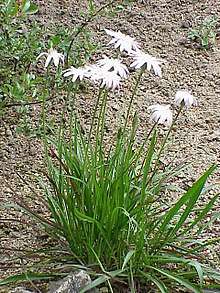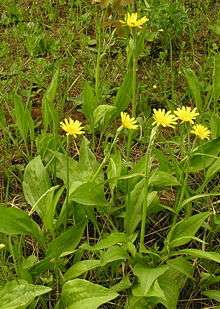Scorzonera
Scorzonera is a genus of flowering plants in the dandelion tribe within the daisy family.[2][3]
| Scorzonera | |
|---|---|
 | |
| Scorzonera purpurea | |
| Scientific classification | |
| Kingdom: | |
| (unranked): | |
| (unranked): | |
| (unranked): | |
| Order: | |
| Family: | |
| Subfamily: | |
| Tribe: | |
| Genus: | Scorzonera |
| Synonyms[1] | |
| |
They are distributed in Europe, Asia,[3] and Africa.[4] Its center of diversity is in the Mediterranean.[5] Well-known species include the edible black salsify (Scorzonera hispanica). Scorzonera tau-saghyz is a source of natural rubber.[6][7][8]
Scorzonera is recorded as a food plant for the larva of the Nutmeg, a species of moth.
Species
The genus contains the following species.[1][9]
- S. acanthoclada
- S. acantholimon
- S. acuminata
- S. adilii
- S. affinis
- S. alaica
- S. alba
- S. albertoregelia
- S. albicans
- S. albicaulis
- S. amasiana
- S. angustifolia
- S. aragatzi
- S. araneosa
- S. argyrea
- S. aristata
- S. aucheriana
- S. austriaca
- S. baetica
- S. baldshuanica
- S. biebersteinii
- S. boissieri
- S. bracteosa
- S. bungei
- S. bupleurifolia
- S. bupleuroides
- S. caespitosa
- S. callosa
- S. calyculata
- S. capito
- S. chantavica
- S. charadzeae
- S. cinerea
- S. circumflexa
- S. codringtonii
- S. communis
- S. crassifolia
- S. cretica
- S. crispa
- S. crocifolia
- S. czerepanovii
- S. darreana
- S. davisii
- S. divaricata
- S. doriae
- S. drarii
- S. dzhawakhetica
- S. elata
- S. elongata
- S. ensifolia
- S. eriophora
- S. euphratica
- S. fengtiensis
- S. ferganica
- S. filifolia
- S. flaccida
- S. franchetii
- S. gageoides
- S. glabra
- S. gorovanica
- S. gracilis
- S. graminifolia
- S. grubovii
- S. helodes
- S. hieraciifolia
- S. hispanica – black salsify, Spanish salsify, viper's-grass, black oyster plant
- S. hispida
- S. hissarica
- S. hondae
- S. hotanica
- S. humifusa
- S. humilis – viper's grass
- S. ikonnikovii
- S. iliensis
- S. inaequiscapa
- S. incisa
- S. inconspicua
- S. intricata
- S. isophylla
- S. ispahanica
- S. joharchii
- S. kandavanica
- S. karabelensis[10]
- S. karataviensis
- S. ketzkhovelii
- S. ketzkhowelii
- S. koelpinioides
- S. kotschyi
- S. kozlowskyi
- S. kuhistanica
- S. lacera
- S. laciniata
- S. lamellata
- S. lanata
- S. lasiocarpa
- S. latifolia
- S. leptophylla
- S. libanotica
- S. limnophila
- S. lindbergii
- S. lipskyi
- S. litwinowii
- S. longiana
- S. longifolia
- S. longipapposa
- S. luntaiensis
- S. luristanica
- S. mackmeliana
- S. manshurica
- S. mariovoensis
- S. microcalathia
- S. mirabilis
- S. mollis
- S. mongolica
- S. mucida
- S. multifida
- S. muriculata
- S. musili
- S. nivalis
- S. ovata
- S. pachycephala
- S. pamirica
- S. papposa
- S. paradoxa
- S. parviflora
- S. persepolitana
- S. persica
- S. petrovii
- S. phaeopappa
- S. pisidica
- S. polyclada
- S. praetuberosa
- S. pratorum
- S. pseudodivaricata
- S. psychrophila
- S. pubescens
- S. pulchra
- S. pygmaea
- S. racemosa
- S. raddeana
- S. radians
- S. radiata
- S. ramosissima
- S. rawii
- S. renzii
- S. reverchonii
- S. rigida
- S. rugulosa
- S. rumicifolia
- S. rupicola
- S. safievii
- S. sahnea
- S. sandrasica
- S. schweinfurthii
- S. scopariiformis
- S. scyria
- S. seidlitzii
- S. semicana
- S. sericea
- S. sericeo-lanata
- S. serpentinica
- S. sinensis
- S. stenocephala
- S. stricta
- S. subacaulis
- S. subaphylla
- S. suberosa
- S. sublanata
- S. syriaca
- S. tadshikorum
- S. tau-saghyz
- S. tenax
- S. tenuisecta
- S. tianshanensis
- S. tomentosa
- S. tortuosissima
- S. tragapogonoides
- S. transiliensis
- S. troodea
- S. tuberculata
- S. tuberosa
- S. tunicata
- S. turkestania
- S. ulrichii
- S. undulata
- S. usbekistanica
- S. veratrifolia
- S. veresczaginii
- S. verrucosa
- S. villosa
- S. violacea
- S. virgata
- S. wendelboi
- S. woronowii
- S. xylobasis
- S. yemensis
- S. yildirimlii[4]
Etymology
| Wikimedia Commons has media related to Scorzonera. |
One possible origin of the genus name is the French scorzonère ("viper’s grass").[3]
Secondary metabolites
Some Scorzonera species contain lactones, including the sesquiterpene lactones known as guaianolides.[11] Flavonoids found in Scorzonera include apigenin, kaempferol, luteolin, and quercetin.[12] Other secondary metabolites reported from the genus include caffeoylquinic acids, coumarins, lignans, stilbenoids, and triterpenoids.[13] One unique class of stilbenoid derivative was first isolated from Scorzonera humilis. They were named the tyrolobibenzyls after Tyrol in the eastern Alps, where the plant was collected.[14]
References
- Flann, C (ed) 2009+ Global Compositae Checklist
- Bremer, K. (1994). Asteraceae: Cladistics and Classification. Timber Press, Portland. ISBN 978-0881922752.
- Scorzonera. Flora of North America.
- Duran, A. and E. Hamzaoglu. (2004). A new species of Scorzonera (Asteraceae) from South Anatolia, Turkey. Biologia-Bratislava 59(1), 47-50.
- Karaer, F. and F. Celep. (2007). Rediscovery of Scorzonera amasiana Hausskn. and Bornm. – A threatened endemic species in Turkey. Bangladesh Journal of Botany 36(2), 139-44.
- Buranov, A. U. and B. J. Elmuradov. (2010). Extraction and characterization of latex and natural rubber from rubber-bearing plants. Journal of Agricultural and Food Chemistry 58(2), 734-43.
- Flora of China Vol. 20-21 Page 198 鸦葱属 ya cong shu Scorzonera Linnaeus, Sp. Pl. 2: 790. 1753.
- Altervista Flora Italiana, genere Scorzonera includes photos and distribution maps
- "The Plant List". Retrieved 22 June 2014.
- Parolly, G. and N. Kilian. (2003). Scorzonera karabelensis (Compositae), a new species from SW Anatolia, with a key to the subscapigerous Scorzonera species in Turkey. Willdenowia 33 327-35.
- Zidorn, C. (2010). "Sesquiterpene lactones and their precursors as chemosystematic markers in the tribe Cichorieae of the Asteraceae". Phytochemistry. 69 (12): 2270–96. doi:10.1016/j.phytochem.2008.06.013. ISSN 0031-9422. PMID 18715600.
- Sareedenchai, V. and C. Zidorn (2010). "Flavonoids as chemosystematic markers in the tribe Cichorieae of the Asteraceae". Biochemical Systematics and Ecology (Amsterdam, the Netherlands). 38 (5): 935–57. doi:10.1016/j.bse.2009.09.006. ISSN 0305-1978.CS1 maint: uses authors parameter (link)
- Jehle, M. et al. (2010). "Natural products from Scorzonera aristata (Asteraceae)". Natural Product Communications. 5 (5): 725–27. doi:10.1177/1934578X1000500510. ISSN 1934-578X.CS1 maint: uses authors parameter (link)
- Zidorn, C. et al. (2000). "Tyrolobibenzyls ‒ Novel secondary metabolites from Scorzonera humilis". Helvetica Chimica Acta (Zürich; Switzerland). 83 (11): 2920–25. doi:10.1002/1522-2675(20001108)83:11<2920::AID-HLCA2920>3.0.CO;2-5. ISSN 0018-019X.CS1 maint: uses authors parameter (link)
